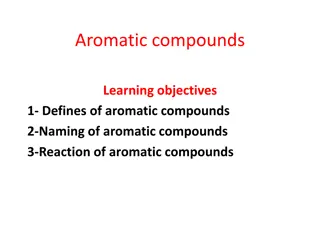Aromatic compounds
Aromatic compounds are chemical compounds containing a ring with delocalized pi electrons. Learn about the definition, naming conventions, and reactions of aromatic compounds such as benzene. Explore topics like aryl groups, halogenation reactions, and the mechanism for bromination of benzene.
0 views • 19 slides
Understanding Benzene and its Electrophilic Aromatic Substitution Reactions
Aromatic compounds like benzene undergo electrophilic aromatic substitution reactions (EAS). This process involves the reaction of an electrophile with the aromatic ring, leading to the formation of various derivatives. Examples include halogenation, nitration, and sulphonation of benzene, each with
0 views • 13 slides
Understanding the Hell-Volhard-Zelinsky Reaction Mechanism
The Hell-Volhard-Zelinsky (HVZ) reaction is a unique halogenation method for carboxylic acids at the alpha carbon, involving phosphorus tribromide and bromine. This mechanism, named after its chemists, requires severe conditions and can lead to specific products or limitations such as beta unsaturat
0 views • 8 slides
Understanding Alkane Reactivity: Bond Fission and Halogenation
Alkanes, known for their low reactivity, can undergo halogenation in the presence of sunlight or UV light to form halogenoalkanes. This reaction is significant due to the non-polar nature of alkane bonds and highlights a rare reactivity pathway for these compounds. The process of bond fission, parti
0 views • 135 slides
Overview of Furan: Preparation, Properties, and Reactions
Furan, a heterocyclic compound, is prepared by distillation of mucic acid or decarbonylation of furfural. It exhibits aromatic character, undergoing addition and substitution reactions like hydrogenation, Diels-Alder reaction, halogenation, nitration, sulphonation, and Friedel-Crafts reaction. Known
0 views • 13 slides
Understanding Benzene and Its Derivatives: Methods, Properties, and Reactions
Explore the methods for preparing benzene, understand its chemical properties and reactions including halogenation, nitration, sulfonation, Friedel-Crafts alkylation, and acylation. Dive into carbon-carbon bond formations and substitution reactions in aromatic compounds.
0 views • 28 slides
Understanding Antimicrobial Agents and Their Mechanisms of Action
Antimicrobial agents play a crucial role in combating harmful microorganisms. They encompass various categories such as antiseptics, disinfectants, germicides, and bacteriostatic agents. Each category targets different types of microbes and serves specific purposes in maintaining public health stand
0 views • 40 slides






